Optimizing Emergency Response in Healthcare Facilities: Integration of Firefighting Technologies and Tactical Evacuation Strategies
Abstract
1. Introduction
- The absence of stable fire extinguishing equipment;
- Flammable materials being stored in the premises of medical facilities;
- Insufficient or incomplete mechanical aids for patients during evacuation;
- The incompetence of hospital staff regarding safety issues;
- Insufficient crisis management methodology;
- The inability of the patients to evacuate the facility;
- The inoperability of emergency lighting, evacuation radios, and other fire-technical equipment due to the interruption of the electricity supply and the inoperability of backup sources;
- The insufficient capacity of evacuation elevators and various barriers on escape routes;
- A lack of special fire-extinguishing agents due to equipment;
- Insufficient access areas for firefighting equipment;
- A failure to meet current fire safety requirements for buildings;
2. Materials and Methods
2.1. The Current State of the Issue
- General hospitals;
- Specialized hospitals;
- Natural treatment spas and healing spas;
- Medical institutions;
- Hospice centers;
- Nursing care homes;
- Biomedical research facilities [34].
- A total of 73 hospitals are general hospitals (GHs), including general hospitals with polyclinics, university faculty hospitals (UFHs), and university faculty hospitals with polyclinics;
- A total of 52 hospitals are specialized hospitals;
2.2. Methodology
2.2.1. Operational–Tactical Characteristics and Location of the Object
- The third basement is designed as an installation floor, which houses a horizontal distribution of all the installations, the electrical distribution, machine rooms, assembly areas, and a parking lot for trucks.
- Most of the second basement’s floor consists of a high-voltage and low-voltage electrical switchboard, transformer rooms, a cooling machine room, and an exchanger station. Furthermore, there is an electrical switchboard for technical operations, a vacuum machine room, a truck parking lot, and warehouses.
- The first basement is the first underground floor, which houses the visitors’ hall, cloakrooms, sales rooms, and services.
2.2.2. Characteristics of Building Structures of the Louis Pasteur University Hospital in Košice
2.2.3. Firefighting Equipment at Louis Pasteur University Hospital
2.2.4. Fire Water Sources
3. Results
- 01:20:40 a.m., zone 4, address 2/87, 4th floor, corridor A (from the department);
- 01:21:19 a.m., zone 4, address 2/86, 4th floor, corridor A (from the department);
- 01:24:07 a.m., zone 4, address 2/90, 4th floor, warehouse A (door number 4A1);
- 01:24:55 a.m., zone 6, address 2/34, 4th floor, corridor A (from the department);
- 01:25:04 a.m., zone 15, address 4/41, 15th floor, corridor A (from the department);
- 01:25:34, zone 5, address 2/109, 5th floor, corridor A (from the department);
- 01:26:31, zone 4, address 2/89, 4th floor, warehouse C (door number 4C16);
- 01:26:44, zone 6, address 2/33, 6th floor, corridor A (from the department);
- 01:27:28, zone 7, address 2/55, 7th floor, corridor A (from the department);
- 01:27:38 11:27:44 a.m., zone 13, address 3/118, 13th floor, corridor A (from the department);
- 01:27:44, zone 4, address 2/93, 4th floor, corridor B (from the department);
- 01:27:52, zone 5, address 2/115, 5th floor, corridor B (from the department);
- 01:28:44, zone 4, address 2/88, 4th floor, electrical substation (door no. Ra-4).
3.1. Description of the Situation Before the Fire Broke out and at the Time It Was Observed
3.2. Situation Before the Fire
3.3. Calculation of Forces and Means
3.3.1. Determination of Forces and Means
- (a)
- The first group includes data on the building and the expected fire, particularly the characteristics of the building parts, production technology, and water supply. In the above case, it is solely up to the operations officer who sends the equipment to eliminate the fire.
- (b)
- The second group includes data on the arrival of fire brigades and the parameters of fire development:
- The form of the fire spread (circular, rectangular, or rectangular);
- The linear speed of the fire spread in a specified direction (v1 in m.min−1);
- The free fire spread time (tvr in min);
- The area of fire before the arrival of the first fire brigades;
- The dimensions of the smoke zone and concentration of combustion products in specific places;
- The time of arrival of the fire brigade;
- The main direction of attack;
- The localization and liquidation of the fire.
- (c)
- The third group includes data on the parameters of fire suppression:
- The intensity of the supply of the extinguishing agent per unit of perimeter (Io in L.min−1.m−1);
- The intensity of the supply of the extinguishing agent per unit of fire volume (Ip in kg.min−1.m−3) (alternatively to 1);
- The required consumption of the extinguishing agent (Qps in L.min−1);
- The actual consumption of the extinguishing agent (Qsk in L.min−1);
- The intensity of the extinguishing agent supply per unit area (Ip in L.min−1.m−2).
- (d)
3.3.2. Determining the Required Supply of Extinguishing Agent
3.3.3. Determining the Required Number of Extinguishing Streams for Extinguishing
3.3.4. Determining the Number of Firefighters Required to Extinguish a Fire
3.3.5. Determining the Number of Tanker Truck Sprayers for Water Supply
3.4. Analysis of Results
3.5. Evacuation
3.6. Organization of Connection and Determination of Radio Networks
- Base radio station Matra OC RD FRS Košice–channel 606–PKO–1;
- Matra handheld radio station–channel 606–PKO–500.
- Base radio station Matra Fire station Košice–Požiarnická–channel 600–PKE–1;
- Base radio station Matra Fire station Košice–Teplárenská–channel 600–PKE–2;
- Base radio station Matra Fire station Košice–Šaca–channel 600–PKE–3;
- Base radio station Matra Fire station Bidovce–channel 601–PKS–2;
- KHA AROCS 5/60–PKE 150;
- CAS 30 T 815 4 × 4–PKE 106;
- CAS 30 T 815–7 6 × 4–PKE 110;
- Bronto 44–PKE 137;
- Evacuation Bus–PKE 180;
- Nissan X-trail–PKE 159.
- MB Vario–PKE 354;
- CAS 30 T 815–7 6 × 4–PKE 306;
- Iveco Daily 10–PKE 302.
- MB Vario–PKE 254;
- MB Atego 30–PKE 232;
- Hyundai i30–PKE 282.
- MB Vario–PKS 254;
- CAS 30 T 815–7 6 × 4–PKS 206.
4. Discussion
4.1. Fire Spread Process Analysis
4.2. Static Inspection on the Fire Scene
4.3. Dynamic Inspection of the Fire Scene
4.4. Fire Source
4.5. Cause of Fire
- The ignition of flammable substances by an unknown person: based on the inspection, the evaluation of traces of the spread of the fire, facts before the fire and at the time of the fire, and the speed of the development and spread of the fire, as well as the evaluation of video recordings, this was probably the cause of the fire.
- Other: given the facts established, no other explanation for the fire was verified.
4.6. Communication Related Issues
4.7. Comparison and Evaluation
- The locations of fire hydrants, building entrances, internal staircases, elevators, and hazardous materials;
- The building construction and occupancy;
- The simulated real-time fire size and location;
- The locations or absence of sprinklers;
- The locations of internal risers, the fire wall ratings, and the locations of fire and emergency medical services equipment;
5. Conclusions
- The fire alarm guidelines did not specify an effective way to declare a fire alarm. The multi-story nature of the building and the difficult conditions for evacuating people from the monoblock building at Tr. SNP 1 in Košice were also not acceptable.
- The documentation did not specify the obligations of employees and authorized persons upon the detection of an alarm to launch a stable fire-extinguishing system in the form of a water curtain.
- The fire alarm guidelines did not provide instructions on when employees and bystanders should remain at their workplaces.
- The documentation did not elaborate on the needs for quick and effective evacuation, and the transmission of the signal from the electric fire alarm system and subsequent verification was very lengthy.
- The evacuation of persons was not carried out and managed by authorized persons.
- The evacuation plan was not prepared in accordance with the actual situation.
- The entity did not maintain in an operational state the fire equipment used for the evacuation of persons: the air conditioning equipment that would ensure the positive pressure ventilation of vertical escape routes.
- The entity did not maintain in an operational state the fire equipment used for the evacuation of persons: the radio equipment installed in the building.
- The entity did not ensure the implementation of training for certain employees.
- Documentation on electrical fire alarm systems was not maintained.
- The inspected entity did not ensure the implementation of the inspection of the electrical fire alarm system installed for the facility.
- The inspected entity did not ensure the proper maintenance of the operating book of the electrical fire alarm system installed in the facility.
- The inspected entity did not maintain the fire equipment—the water curtain—installed in accordance with the project documentation in an operational state.
- The inspected entity did not maintain the fire equipment—the water supply equipment for fire extinguishing, i.e., a non-flooded riser pipe in the facility—in an operational state.
- The inspected entity did not ensure the implementation of a regular inspection of the fire water supply equipment.
- The inspected entity did not maintain the fire equipment—the internal fire water supply with wall hydrants installed in the facility—in an operational state.
- The inspected entity did not maintain the fire equipment—the external fire water supply—in an operational state.
- -
- Personnel procedures when carrying out evacuation;
- -
- The need to comply with fire protection documentation;
- -
- Ensuring the temporary accommodation of evacuees;
- -
- Ensuring high-quality technical solutions for firefighting equipment and its functionality.
Author Contributions
Funding
Institutional Review Board Statement
Informed Consent Statement
Data Availability Statement
Acknowledgments
Conflicts of Interest
References
- Mufti, S.; Khalil, I.; Rashid, H.; Hamid, S.; Mufti, H.; Jan, F.A. Critical analysis of fire incidents and self-assessment of fire safety program in_a tertiary care hospital of India an observational study. Int. J. Community Med. Public Health 2024, 11, 140–150. [Google Scholar] [CrossRef]
- Wood, M.H.; Hailwood, M.; Kuetelos, K. Reducing the risk of oxygen-related fires and explosions in hospitals treating Covid-19 patients. Process Saf. Environ. Prot. 2021, 153, 278–288. [Google Scholar] [CrossRef] [PubMed]
- Apfelbaum, J.L.; Caplan, R.A.; Barker, S.J.; Connis, R.T.; Cowles, C.; Ehrenwerth, J.; Nickinovich, D.G.; Pritchard, D.; Roberson, D.W. Practice advisory for the prevention and management of operating room fires: An updated report by the American Society of Anesthesiologists Task Force on Operating Room Fires. Anesthesiology 2013, 118, 271–290. [Google Scholar] [CrossRef] [PubMed]
- Chowdhury, K. Fires in Indian hospitals: Root cause analysis andrecommendations for their prevention. J. Clin. Anesth. 2013, 26, 414–424. [Google Scholar] [CrossRef] [PubMed]
- Tomasková, M.; Baláziková, M.; Krajnák, J. Hazards Related to Activities of Fire-Rescue Department Members during the Covid-19 Pandemic. Sci. J. Silesian Univ. Technol. Ser. Transp. 2022, 117, 247–260. [Google Scholar] [CrossRef]
- Dhaliwal, N.; Bhogal, R.S.; Kumar, A.; Gupta, A.K. Responding to fire in an intensive care unit: Management and lessons learned. World J. Emerg. Med. 2018, 9, 154–156. [Google Scholar] [CrossRef]
- Güdük, Ö. Investigation of Fires Occuring in Hospitals Between 2019-2023 in Türkiye: A Content Analysis. J. Disaster Risk 2024, 7, 743–757. [Google Scholar] [CrossRef]
- Murphy, G.R.F.; Foot, C. ICU fire evacuation preparedness in London: A cross-sectional study. Br. J. Anaesth 2011, 106, 695–698. [Google Scholar] [CrossRef][Green Version]
- Jones, T.S.; Black, I.H.; Robinson, T.N.; Jones, E.L. Operating Room Fires. Anesthesiology 2019, 130, 492–501. [Google Scholar] [CrossRef] [PubMed]
- Watson, D.S. New recommendations for prevention of surgical fires. AORN J. 2010, 91, 463–469. [Google Scholar] [CrossRef] [PubMed]
- Rinder, C.S. Fire safety in the operating room. Curr. Opin. Anaesthesiol. 2008, 21, 790–795. [Google Scholar] [CrossRef] [PubMed]
- Siddharth, S.R.; Pyreddy, S.R.; Panthagani, S.N. A study on reported fire incidents in major hospitals of India. Int. J. Community Med. Public Health 2020, 7, 3896–3906. [Google Scholar] [CrossRef]
- Sharma, R.; Ashok, K.; Vipin, K. Fire Incidents InHealthcare Organizations: Readiness, Response AndPreparedness. Int. J. Sci. Res. 2019, 8, 2277–2817. [Google Scholar] [CrossRef]
- Sharma, R.; Bakshi, H.; Banerjee, A. Fire Safety Hazards: How Safe Are Our Hospitals? Indian J. Community Med. 2020, 45, 104–105. [Google Scholar] [CrossRef] [PubMed]
- Salleh, N.; Aras, A.S.N.; Norazman, N.; Kamaruzzaman, S.N. Fire risk assessment of Malaysia public hospital buildings. J. Facil. Manag. 2023, 21, 635–650. [Google Scholar] [CrossRef]
- Tomaskova, M.; Pokorny, J.; Kucera, P.; Balazikova, M.; Marasova, D. Fire Models as a Tool for Evaluation of Energy Balance in Burning Space Relating to Building Structures. Appl. Sci 2022, 12, 2505. [Google Scholar] [CrossRef]
- Pokorny, J.; Tomaskova, M.; Balazikova, M. Study of changes for selected fire parameters at activation of devices for smoke and heat removal and at activation of fixed extinguishing device. MM Sci. J. 2015, 4, 764–767. [Google Scholar] [CrossRef]
- Altaie, M.R.; Muhsin, I.F.; Dishar, M.M. Managing the Utilization of Preventive Measures for Fire Resistance in the Hospitals. Civ. Environ. Eng. 2023, 19, 520–531. [Google Scholar] [CrossRef]
- Boyd, A.; Chambers, N.; French, S.; King, R.; Whitehead, K. Emergencyplanning, management in health care: Priority research topics. Health Syst. 2013, 3, 83–92. [Google Scholar] [CrossRef] [PubMed]
- Brzezińska, D.; Bryant, P. Risk Index Method-A Tool for Building Fire Safety Assessments. Appl. Sci. 2021, 11, 3566. [Google Scholar] [CrossRef]
- Osvaldova Makovicka, L.; Gaspercova, S. The Evaluation of Flammability PropertiesRegarding Testing Methods. Civ. Environ. Eng. 2015, 11, 142–146. [Google Scholar] [CrossRef][Green Version]
- Park, H.; Meacham, B.J.; Dembsey, N.A.; Goulthrope, M. Conceptual Model Development for Holistic Building Fire Safety Performance Analysis. Fire Technol. 2013, 51, 173–193. [Google Scholar] [CrossRef]
- Kadhim, E.M.; Altaie, M.R. Factors Affecting Building Maintenance Practices:Review. J. Eng. 2023, 29, 153–172. [Google Scholar] [CrossRef]
- Kadhim, E.M.; Altaie, M.R. Factors Affecting Maintenance Practises in Iraq’s Hospital Buildings. Jordan J. Civ. Eng. 2023, 17, 408–418. [Google Scholar] [CrossRef]
- Yilmaz, D. Fire Safety and Prevention Issues in Design of Tall Buildings. Int. J. Archit. Eng. Technol. 2022, 9, 138–150. [Google Scholar] [CrossRef]
- Altaia, M.R.; Dishar, M.M.; Muhsin, F.I. Fundamental Challenges and Management Opportunities in Post Disaster Reconstruction Project. Civ. Eng. J. 2023, 9, 2161–2174. [Google Scholar] [CrossRef]
- Hicks, J.; Glick, R. A meta-analysis of hospital evacuations: Overcoming barriers to effective planning. J Health Risk Manag 2015, 34, 26–36. [Google Scholar] [CrossRef] [PubMed]
- Kaye, A.D.; Kolinsky, D.; Urman, R.D. Management of a fire in the operating room. J. Anesth. 2014, 28, 279–287. [Google Scholar] [CrossRef]
- Huang, D.C.; Chien, S.W.; Lin, C.H.; Huang, P.T.; Song, Y.T.; Sie, H.R. A study for the evacuation of hospital on fire during construction. Procedia Eng. 2011, 11, 139–146. [Google Scholar] [CrossRef]
- Childers, A.; Visagamurthy, G.; Taaffe, K. Prioritizing Patients for Evacuation from a Health-Care Facility. Transp. Res. Rec. J. Transp. Res. Board. 2009, 2137, 38–45. [Google Scholar] [CrossRef]
- Wabo, C.; Örtenwall, P.; Khorram-Manesch, A. Hospital evacuation; planning, assessment, performance and evaluation. J. Acute Dis. 2012, 1, 56–58. [Google Scholar] [CrossRef]
- The Decree of the Ministry of Health of the Slovak Republic No. 770/2004 Coll. on Determining the Characteristics of Individual Healthcare Facilities Is as Follows: Institutional Healthcare Facilities and Outpatient Healthcare Facilities. Available online: https://www.slov-lex.sk/ezbierky/pravne-predpisy/SK/ZZ/2004/770/20051015.html (accessed on 9 September 2023).
- Gavurová, B.; Kubak, M. Satisfaction of inpatients with health care facilities and medical services in Slovak Republic. Econ. Res. Ekon. Istraživanja 2022, 35, 1–19. [Google Scholar] [CrossRef]
- Kapalla, M.; Kapallová, D.; Turecký, L. An overview of the healthcare system in the Slovak Republic. EPMA J. 2010, 1, 549–561. [Google Scholar] [CrossRef] [PubMed]
- Smatana, M.; Pažitný, P.; Kandilaki, D.; Laktišová, M.; Sedláková, D.; Palušková, M.; van Ginneken, E.; Spranger, A.; World Health Organization. Slovakia: Health system review. Health Syst. Transit. 2016, 18, 1–210. [Google Scholar] [PubMed]
- Informative Location of Hospitals in the Slovak Republic. Available online: https://www.rra-nitra.sk/wp-content/uploads/2009/07/oph-en-upozornenie-mz-sr-anglicky-preklad-nemozno-povazovat-za-oficialny-dokument.pdf (accessed on 10 September 2023).
- Kľučka, J.; Mózer, V.; Dvorskí, J. Fire Losses in the Slovak Republic-Their Classification and Quantification. Commun.—Sci. Lett. Univ. Zilina 2015, 17, 1. [Google Scholar] [CrossRef]
- Gavurová, B.; Kováč, V.; Fedačko, J. Regional disparities in medical equipment distribution in the Slovak Republic–a platform for a health policy regulatory mechanism. Health Econ. Rev. 2017, 7, 39. [Google Scholar] [CrossRef] [PubMed]
- Gavurova, B.; Kocisova, K. The Efficiency of Hospitals: Platform for Sustainable Health Care System. Entrep. Sustain. Issues 2020, 8, 133–146. [Google Scholar] [CrossRef]
- Pavol Jozef Šafárik University, Faculty of Medicine (UPJS FM), Louis Pasteur University Hospital (LPUH) and Child Teaching Hospital (ChTH), Trieda SNP 1. Available online: https://www.upjs.sk/lekarska-fakulta/en/address-and-contacts/orientation-map/trieda-snp-street/ (accessed on 9 January 2024).
- STN 92 0201-2; Fire Safety of Buildings. Common Provisions. Part 2: Building Structures. Available online: https://www.normoff.gov.sk/stranka/541/stn-online/ (accessed on 1 February 2025).
- STN EN 1991-1-2; Eurocode 1. Actions on Structures. Part 1–2: General actions. Actions on Structures Exposed to Fire. Available online: https://www.normoff.gov.sk/stranka/541/stn-online/ (accessed on 1 February 2025).
- Ministry of the Interior of The Slovak Republic Home Page. Presidium of the Fire and Rescue Service. Collection of Instructions of the President of the Fire and Rescue Service. About the Content and Procedure for Processing Documentation on Fighting Fires. Available online: https://www.minv.sk/?interne-predpisy-1 (accessed on 2 February 2025).
- Ministry of the Interior of The Slovak Republic Home Page. Presidium of the Fire and Rescue Service. Collection of Instructions of the President of the Fire and Rescue Service. About the Methods of Calculating Forces and Resources. Available online: https://www.minv.sk/?interne-predpisy-1 (accessed on 2 February 2025).
- Presidium of the Fire and Rescue Service Home Page. Order of the President of the Fire and Rescue Service. Tactical-Methodical Procedure for Carrying Out Interventions No. 22. Extinguishing Fires in Heavy Smoke. Available online: https://elearnhazz-sk.webnode.sk/subory-na-stiahnutie/metodicke-listy/ (accessed on 2 February 2025).
- Betuš, M.; Konček, M.; Šofranko, M.; Čambal, J.; Ondov, M. Methods of Extinguishing Fires in Objects with High Voltage. Fire 2023, 6, 442. [Google Scholar] [CrossRef]
- Presidium of the Fire and Rescue Service Home Page. Tactical-Methodical Procedure for Carrying Out Interventions No. 23. Overpressure Ventilation in Fire Fighting. Available online: https://elearnhazz-sk.webnode.sk/subory-na-stiahnutie/metodicke-listy/ (accessed on 2 February 2025).
- Presidium of the Fire and Rescue Service Home Page. Order of the President of the Fire and Rescue Service. Tactical-Methodical Procedure for Carrying Out Interventions No. 7. Rescue of Persons. Available online: https://elearnhazz-sk.webnode.sk/subory-na-stiahnutie/metodicke-listy/ (accessed on 2 February 2025).
- Presidium of the Fire and Rescue Service Home Page. Order of the President of the Fire and Rescue Service. Tactical-Methodical Procedure for Carrying Out Interventions No. 75. In Healthcare Facilities, Social Facilities and Educational Facilities. Available online: https://elearnhazz-sk.webnode.sk/subory-na-stiahnutie/metodicke-listy/ (accessed on 2 February 2025).
- Van der Meer, T.L.A.; Verhoeven, P.; Beentjes, H.W.J.; Vliengenthert, R. Communication in tumes of crisis: The stakeholder relationship under pressure. Public Relat. Rev. 2017, 43, 426–440. [Google Scholar] [CrossRef]
- Huang, Y.; Lo, S.M.; Yang, L.; Gao, L.; Lo, J. Hospital Evacuation under Fire: Risk Identification and Future Prospect. In Proceedings of the 2019 9th International Conference on Fire Science and Fire Protection Engineering (ICFSFPE), Chengdu, China, 18–20 October 2019. [Google Scholar] [CrossRef]
- Choudhari, A.H.; Kausar, M.; Satpathy, S.; Sarma, D.K. Fire Safety Related Challenges Faced by Existing Hospitals: A Review. Med. Leg. Update 2020, 20, 440–446. [Google Scholar] [CrossRef]
- Grant, C. Research Roadmap for Smart Fire Fighting. Fire Protection Research Foundation: NIST Special Publication 1191; National Institute of Standards and Technology: Gaithersburg, MD, USA, 2015. [Google Scholar] [CrossRef]
- The National Fire Protection Association. NFPA 99 Health Care Facilities Code. Int. Codes Stand. Organ. 2024, 272. Available online: https://fire-gas.com/wp-content/uploads/2024/06/NFPA-99-2024-Health-Care-Facilities-Code.pdf (accessed on 2 February 2025).
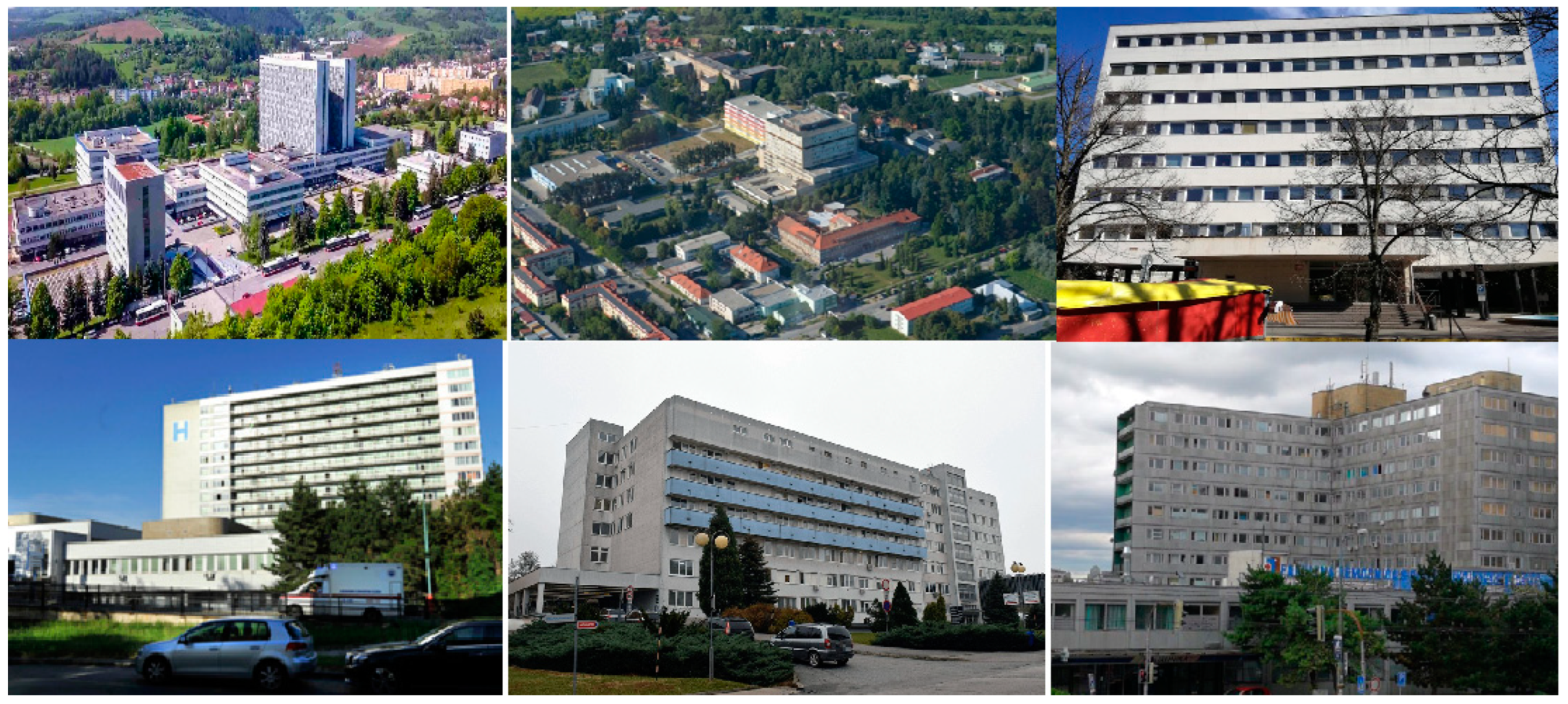

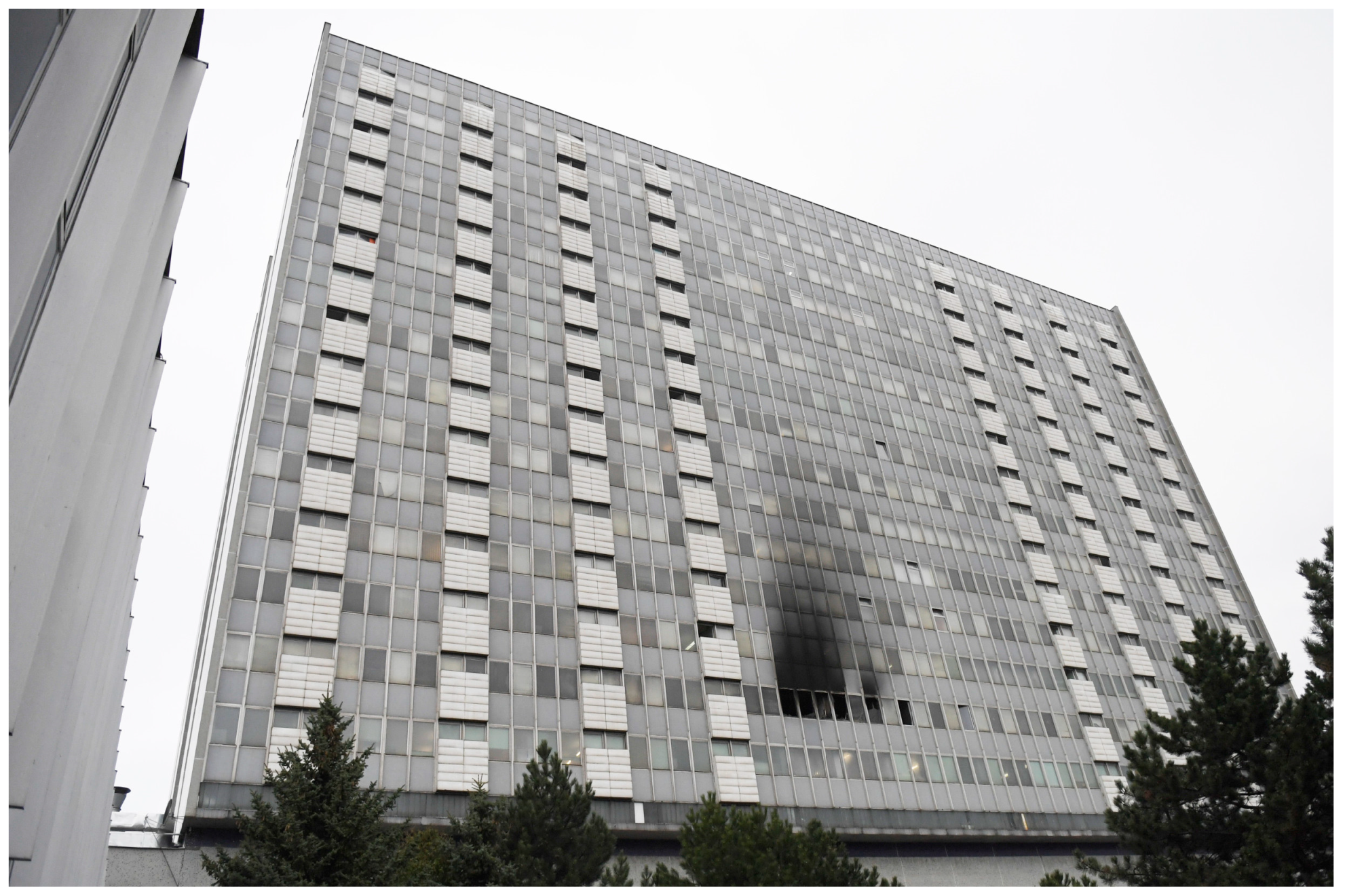

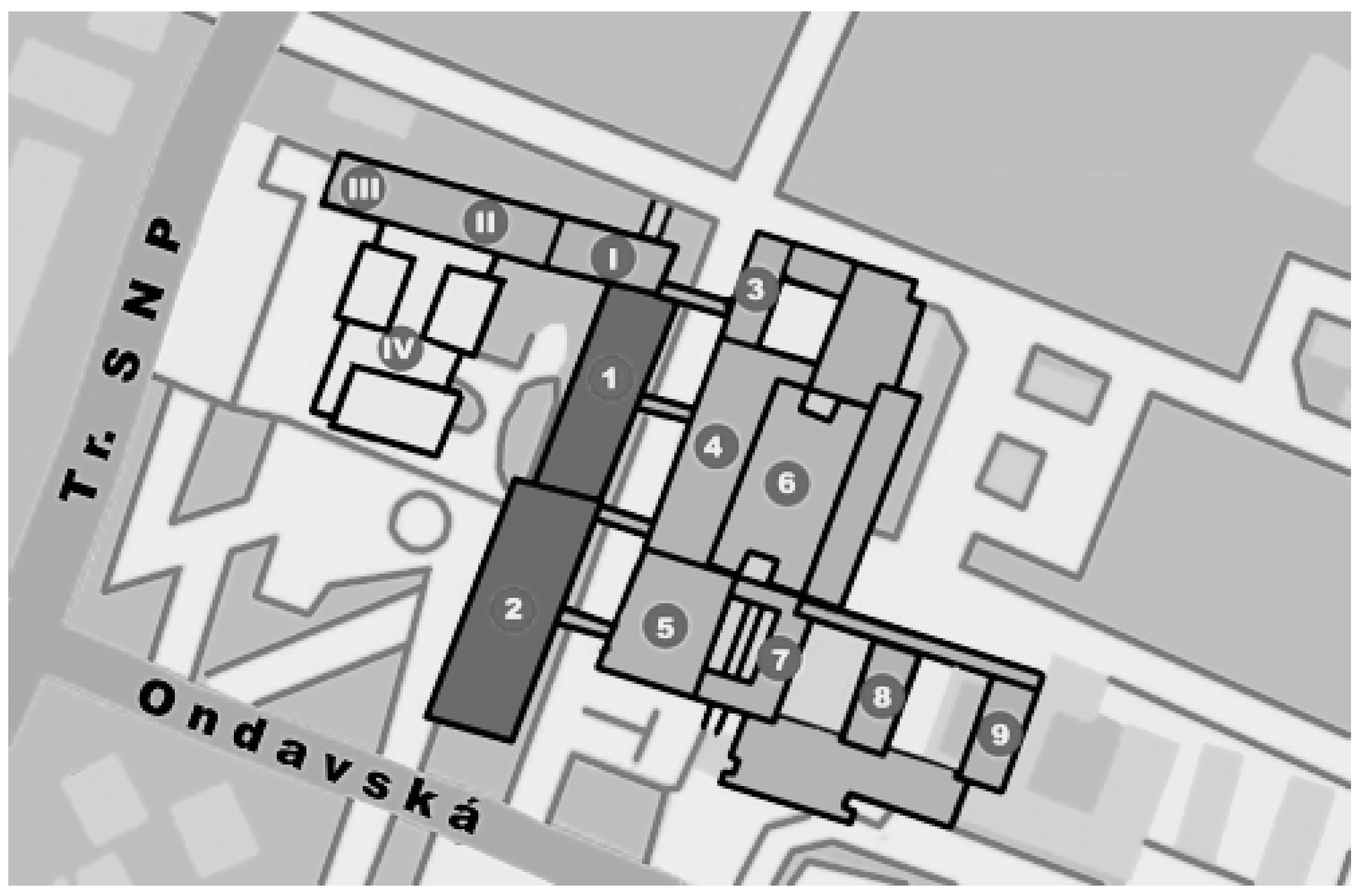
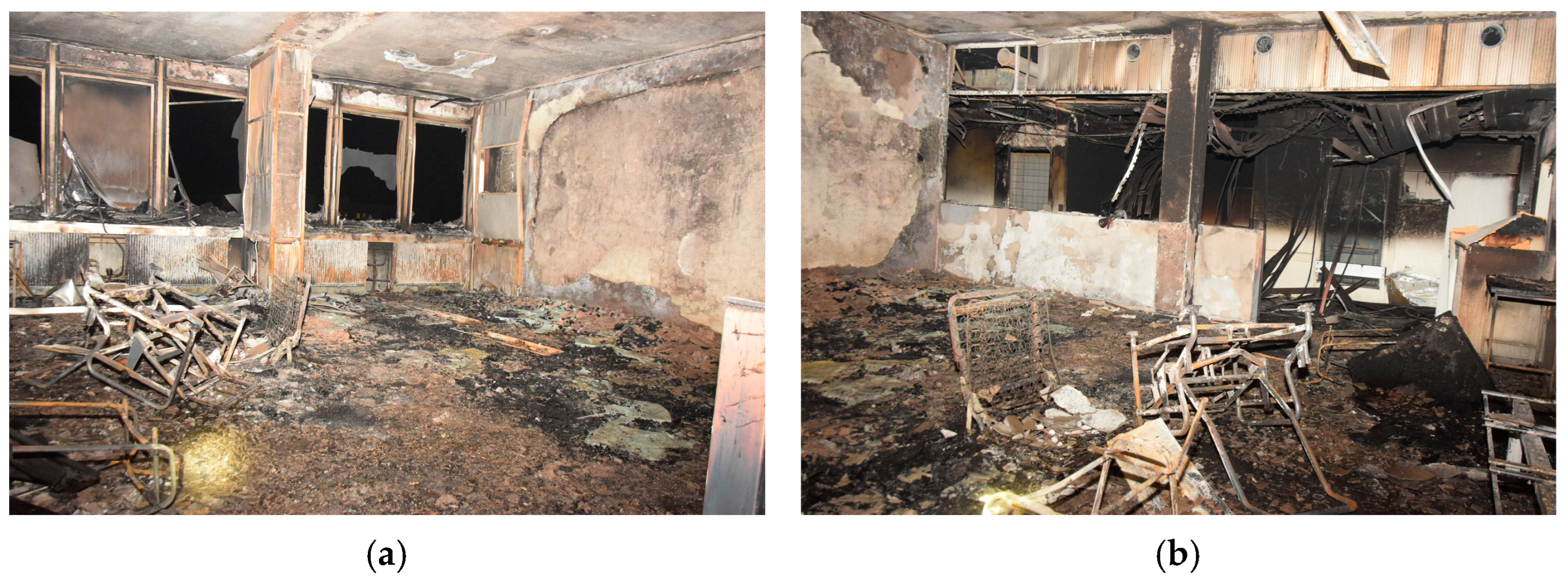
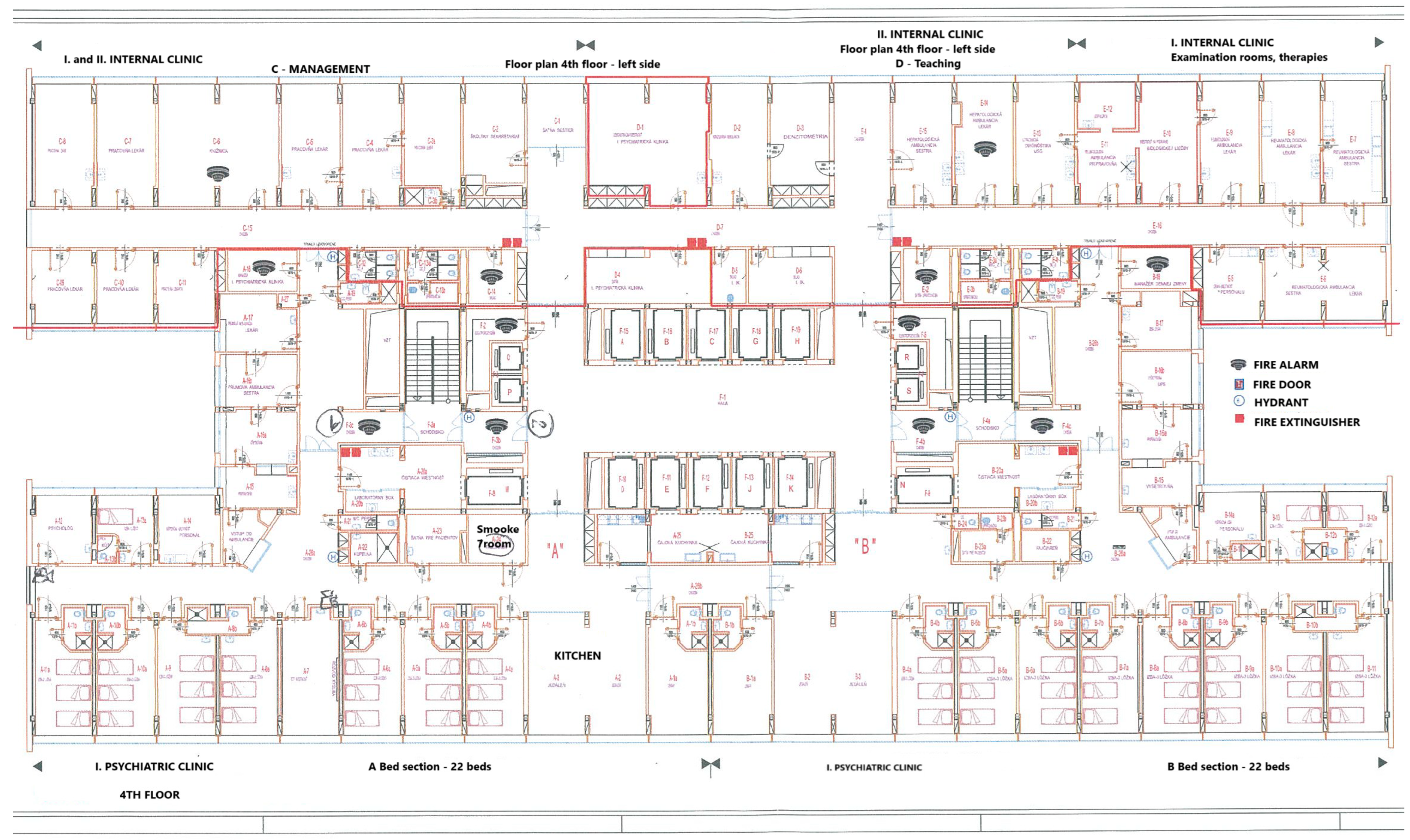
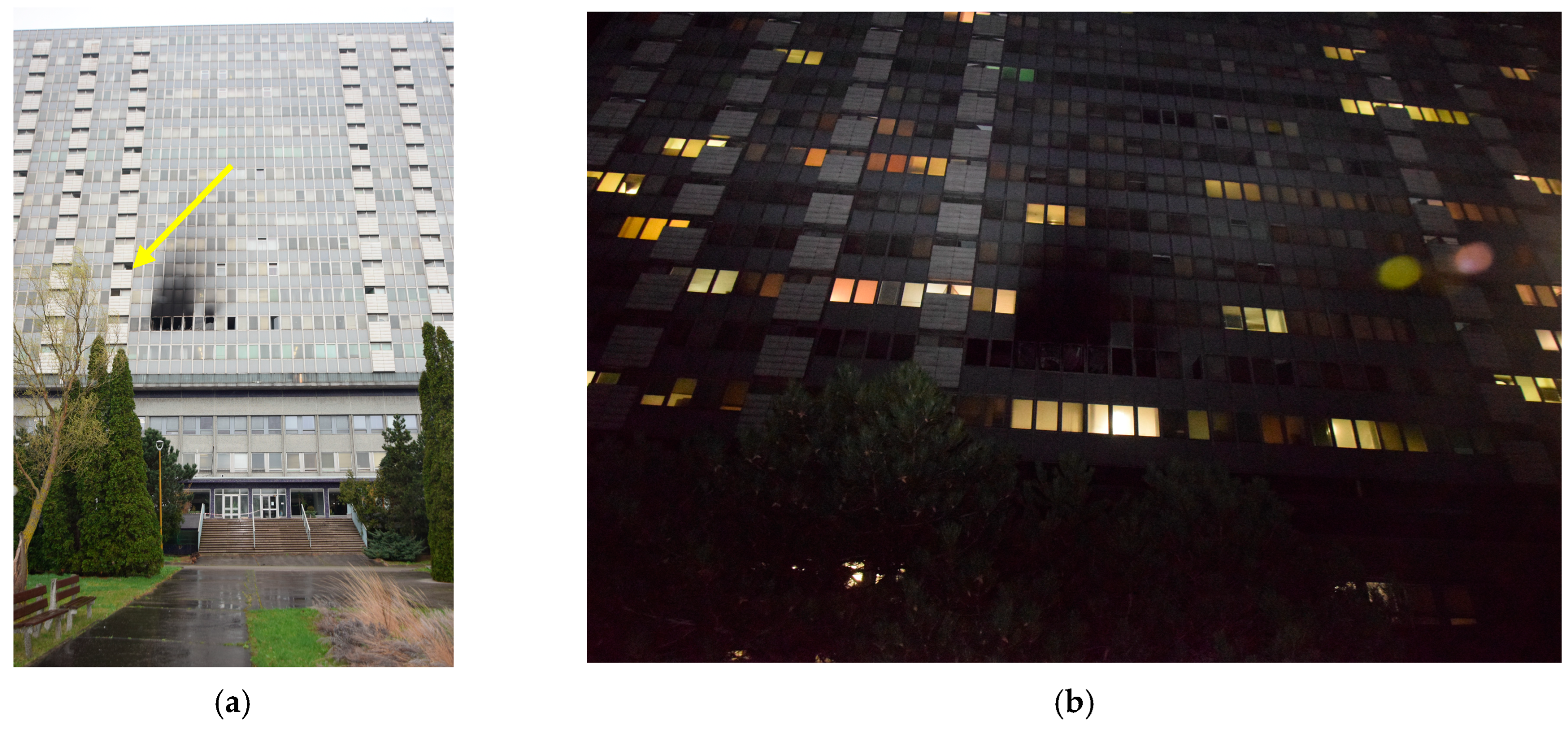
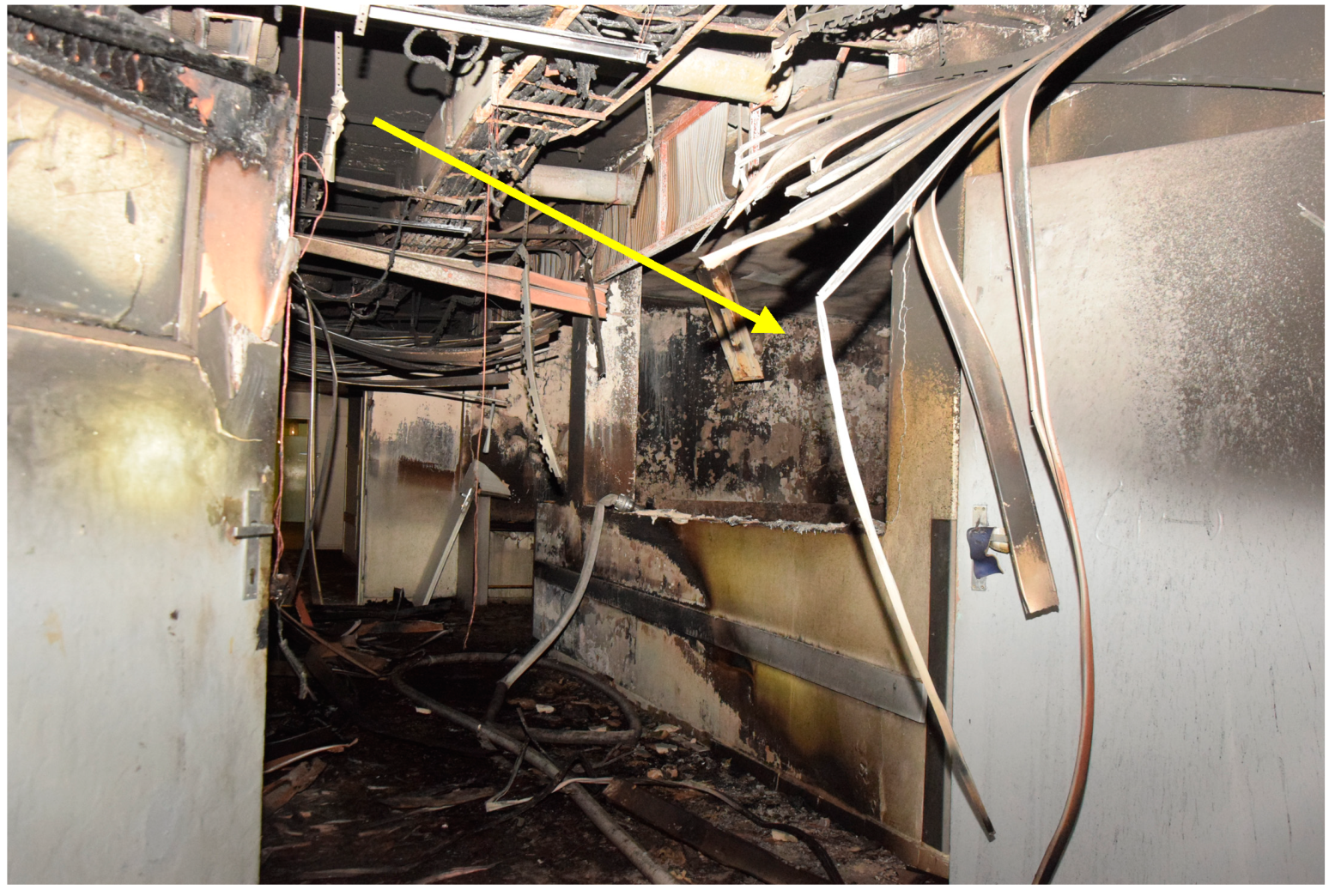
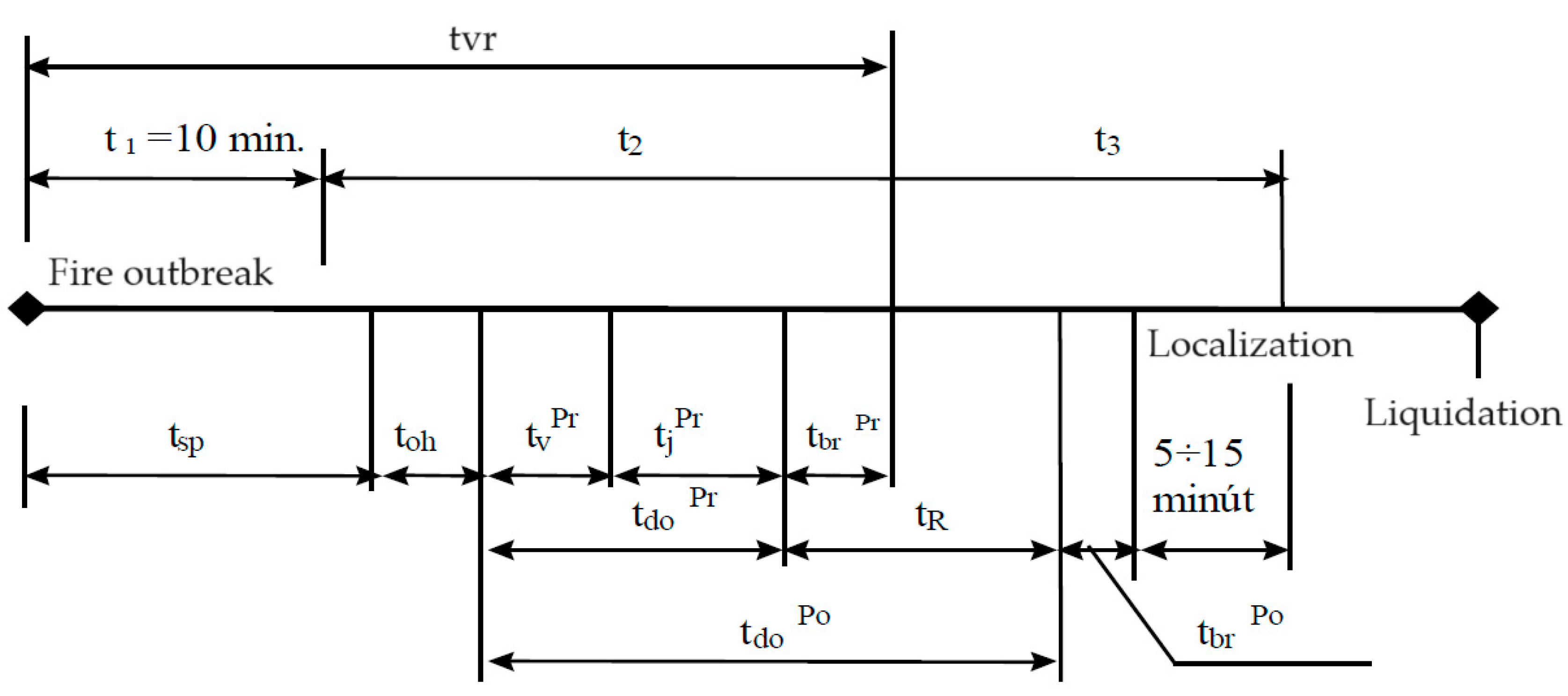
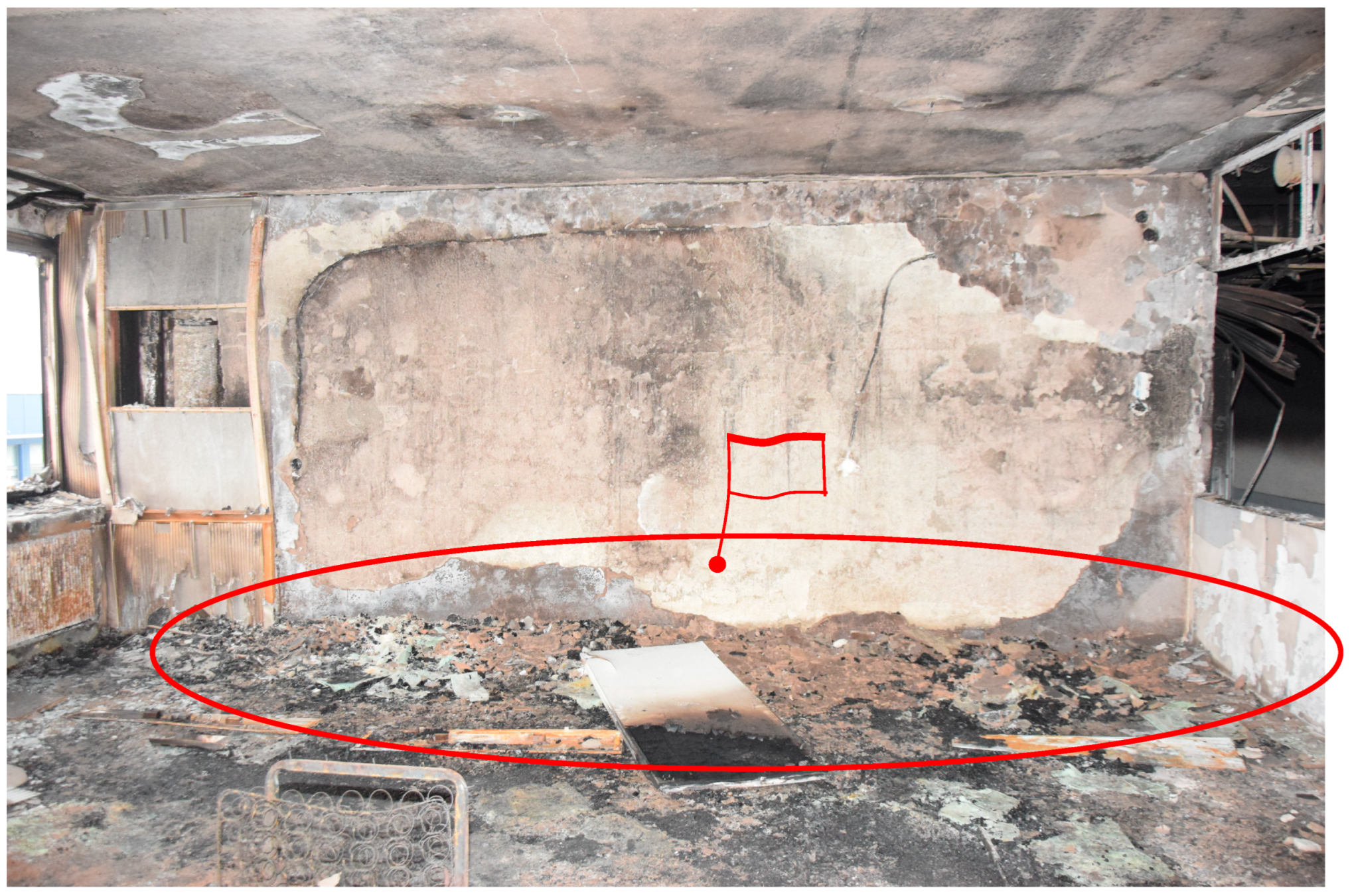
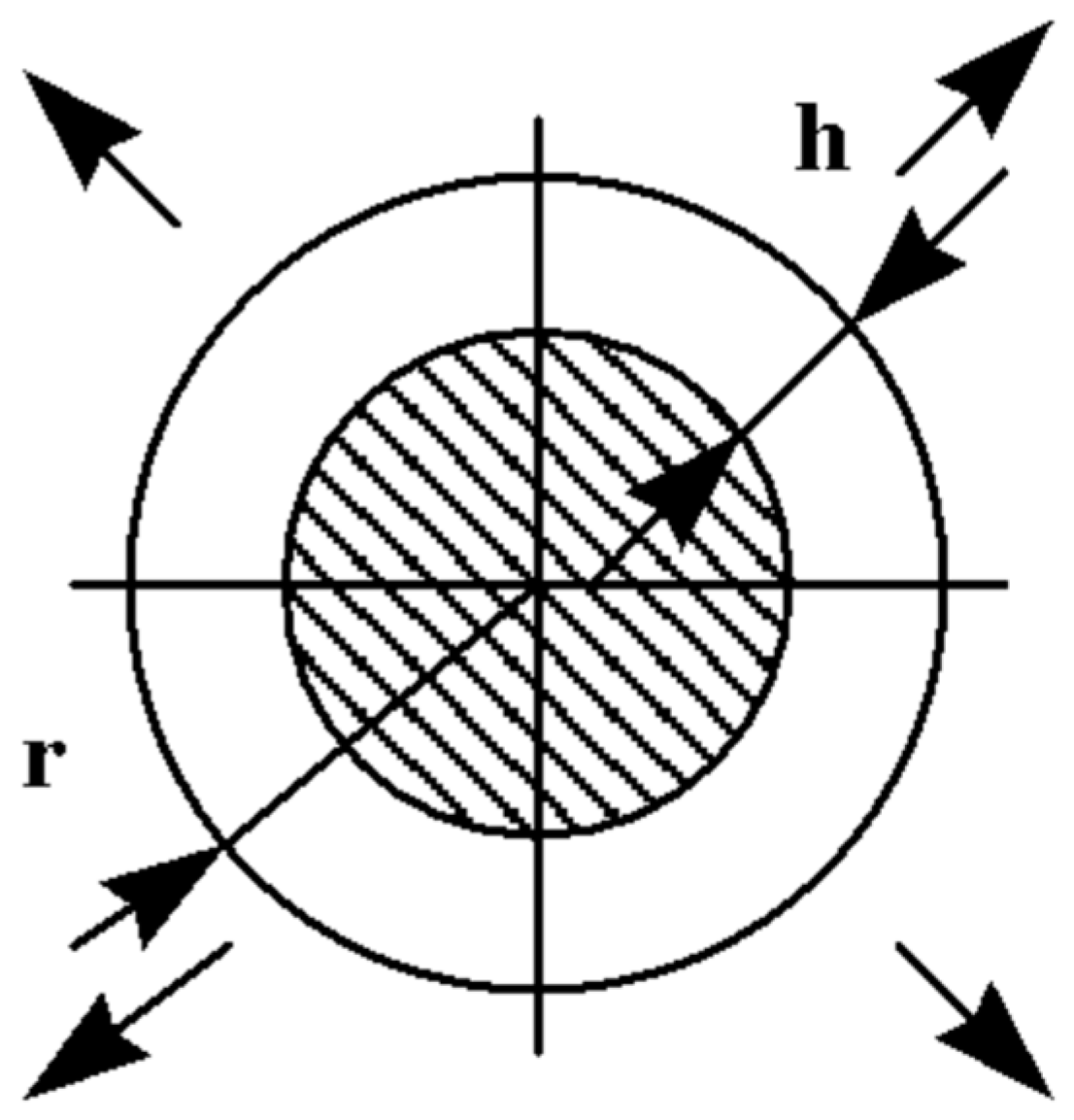
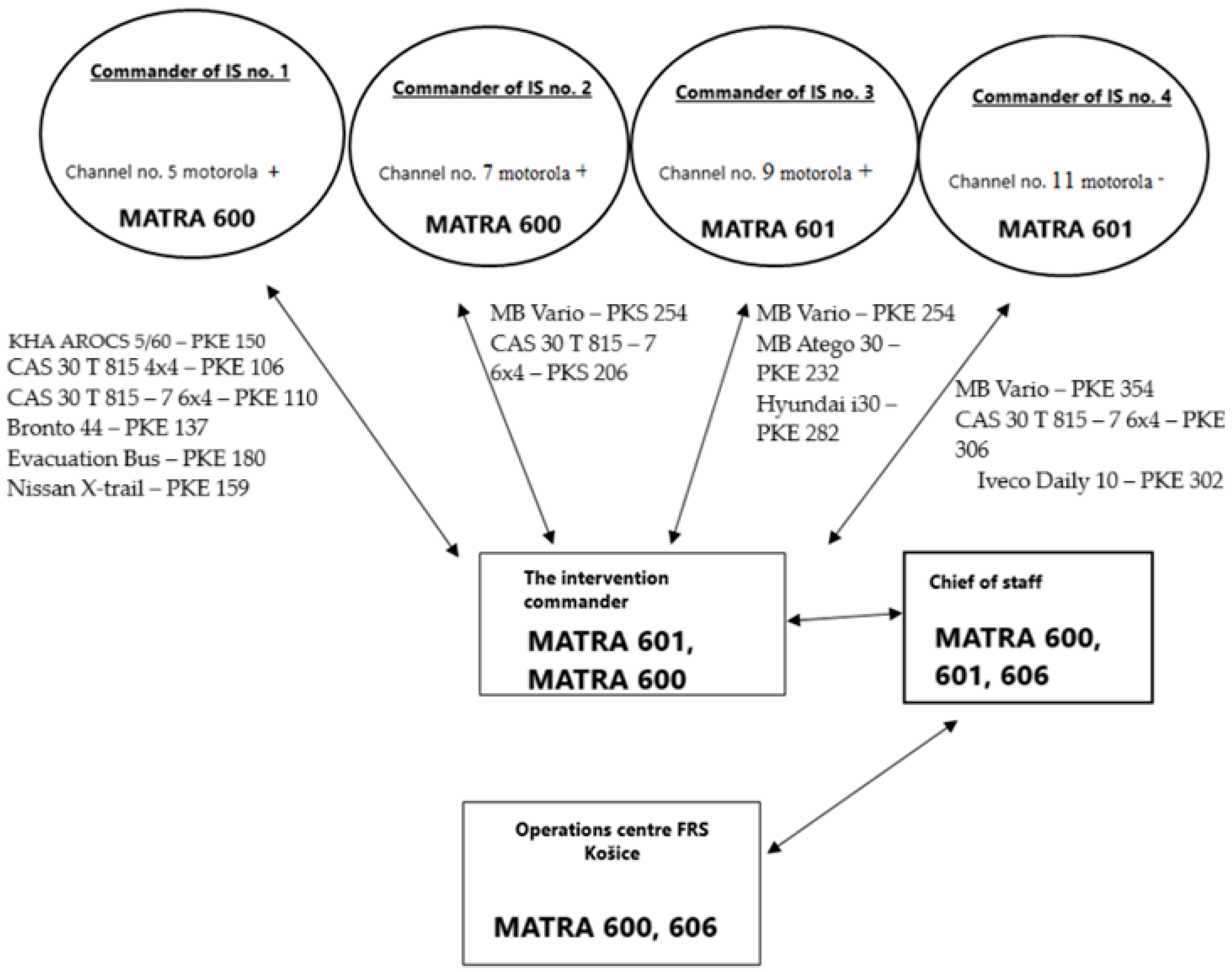

| Inpatient Healthcare Facilities Including Outpatient Departments | WS | CS | ES | “Convergence” Objective | BA | SR | ||||
|---|---|---|---|---|---|---|---|---|---|---|
| TT | TN | NR | ZA | BB | PO | KE | ||||
| General hospitals | 6 | 10 | 8 | 6 | 13 | 13 | 11 | 67 | 6 | 73 |
| Specialized hospitals | 3 | 1 | 5 | 4 | 6 | 9 | 8 | 36 | 16 | 52 |
| Others (natural treatment spas, healing spas, spas, hospice centers, nursing healthcare centers, and biometrical research facilities) | 5 | 3 | 1 | 7 | 10 | 12 | 4 | 42 | 5 | 47 |
| Total | 12 | 16 | 14 | 17 | 29 | 34 | 23 | 145 | 27 | 172 |
| Healthcare Provider/Owner | WS | CS | ES | BA | SR | ||||
|---|---|---|---|---|---|---|---|---|---|
| TT | TN | NR | BB | ZA | PO | KE | |||
| The Ministry of Health SR (including Inc. and non- profit organizations with 100% interest of the state) | 4 | 3 | 6 | 13 | 6 | 8 | 11 | 10 | 61 |
| Other central bodies of state administration: the Ministry of Defense SR, the Ministry of Interior SR, and the Ministry of Justice SR (including Inc. with 100% interest of the state) | 0 | 1 | 0 | 0 | 1 | 2 | 0 | 2 | 6 |
| Public (self-governing region, municipality) | 4 | 4 | 2 | 2 | 5 | 3 | 1 | 1 | 22 |
| Other (Inc., Ltd., non-profit organization) | 4 | 8 | 14 | 14 | 5 | 21 | 11 | 14 | 83 |
| Total | 12 | 16 | 14 | 29 | 17 | 34 | 23 | 27 | 172 |
| Year | Total Number of Fires | Number of Fires in Hospital Facilities | Material Damage in EUR | Number of Deaths | Number of Injured Persons |
|---|---|---|---|---|---|
| 2016 | 8.407 | 14 | 363.140 | 0 | 1 |
| 2017 | 10.312 | 7 | 90.430 | 0 | 1 |
| 2018 | 8.973 | 16 | 106.810 | 0 | 1 |
| 2019 | 9.304 | 12 | 124.850 | 0 | 0 |
| 2020 | 8.356 | 14 | 17.650 | 1 | 1 |
| 2021 | 7.710 | 11 | 560.400 | 0 | 5 |
| 2022 | 10.729 | 9 | 200.500 | 1 | 3 |
| 2023 | 6.800 | 10 | 356.700 | 1 | 5 |
| I | Theoretical Institutes, Section I | |
| II | Theoretical Institutes, Section II | |
| III | Theoretical Institutes, Section III | |
| IV | Library and Auditoriums, Section IV | |
| 2 | Polyclinic, High Section | |
| 3 | Monoblock Base | |
| 4 | Monoblock Base | |
| 6 | Monoblock | |
| 1st floor A—Department of Clinical Biochemistry | 1st floor B—Nephrology and Dialysis Center | |
| 2nd floor A—1st Clinic of Anesthesiology and Intensive Care | 2nd floor B—1st Clinic of Radiodiagnostics and Imaging Methods | |
| 3rd floor A—1st Internal Medicine Clinic, Intensive and Metabolic Care Unit | 3rd floor B—1st Internal Medicine Clinic | |
| 4th floor A—1st Psychiatric Clinic | 4th floor B—1st Psychiatric Clinic | |
| 5th floor A—1st Psychiatric Clinic | 5th floor B—3rd Internal Medicine Clinic | |
| 6th floor A—Neurology Clinic | 6th floor B–Neurology Clinic | |
| 7th floor A—1st Psychiatric Clinic | 7th floor B—Clinic of Physiatry, Balneology and Medical Rehabilitation | |
| 8th floor A—Clinic of Hematology and Oncohematology | 8th floor B—Clinic of Dermatovenerology | |
| 9th floor A—1st Dental Clinic | 9th floor B—Clinic of Otorhinolaryngology and Head and Neck Surgery | |
| 10th floor A—Eye Clinic | 10th floor B—Nephrology Department; (Transplantation Department) | |
| 11th floor A—Urology Clinic | 11th floor B—Urology Clinic | |
| 12th floor A—Clinic of Orthopedics and Traumatology of the Musculoskeletal System | 12th floor B—Clinic of Orthopedics and Traumatology of the Musculoskeletal System | |
| 13th floor A—Clinic of Neurosurgery | 13th floor B—Clinic of Neurosurgery | |
| 14th floor A—1st Department of Surgery | 14th floor A—1st Department of Surgery | |
| 15th floor A—1st Department of Surgery | 15th floor B—Department of Pediatric Surgery | |
| 16th floor A—1st Department of Gynecology and Obstetrics | 16th floor B—Clinic of Neonatology | |
| 17th floor A—1st Department of Gynecology and Obstetrics, Obstetrics Department, Neonatology Department | 17th floor B—Neonatology Department | |
| 7 | Monoblock Base | |
| 8 | Monoblock Base | |
| 9 | Monoblock Base | |
| Equipment | Number of Firefighters | Distance from the Fire Station (km) | Arrival Time (min) |
|---|---|---|---|
| Fire station Košice–Požiarnická | |||
| KHA AROCS 5/60 | 1 + 2 | 3 | 5 |
| CAS 30 T 815 4 × 4 | 1 + 5 | 3 | 5 |
| CAS 30 T 815–7 6 × 4 | 1 + 2 | 3 | 5 |
| Evacuation Bus | 1 + 0 | 3 | 5 |
| Nissan X-trail | 1 + 0 | 3 | 5 |
| Bronto 44 | 1 + 1 | 3 | 5 |
| Fire station Košice–Teplárenská | |||
| MB Vario | 1 + 1 | 6.2 | 9.3 |
| CAS 30 T 815–7 6 × 4 | 1 + 1 | 6.2 | 9.3 |
| Iveco Daily 10 | 1 + 0 | 6.2 | 9.3 |
| Fire station Košice–Šaca | |||
| MB Vario | 1 + 1 | 14.7 | 20.6 |
| MA Atego 30 | 1 + 0 | 14.7 | 20.6 |
| Hyundai i30 | 1 + 0 | 14.7 | 20.6 |
| Fire station Košice–Bidovce | |||
| CAS 30 T 815–7 6 × 4 | 1 + 1 | 17.7 | 24.6 |
| MB Vario | 1 + 1 | 17.7 | 24.6 |
| Time | Situation on the Spot | Orders and Regulations | Activity of Fire Brigades and Other Participating Units |
|---|---|---|---|
| 01:20–01:25 | The detectors of the electric fire alarm System recorded the accompanying phenomena of the fire. | Check performed by employees. | |
| 01:27 | The emergency number is called. | The operations officer evaluates and verifies the call. | |
| 01:30 | Free spread of fire. | Fire alarm declaration. | |
| 01:31 | Free spread of fire. | Fire brigade departure from Košice-Požiarnická. | |
| 01:36 | Free spread of fire. | The fire department is conducting a survey. | Firefighters from Košice-Požiarnická on site. |
| 01:36 | Free spread of fire. | Starting the intervention. | Firefighting, evacuation, and survey work underway. |
| 01:48 | Free spread of fire. | The intervention commander requests the operations center for assistance and additional equipment. | Fire brigade from Košice–Teplárenská departs to the scene of the incident. |
| 01:54 | Free spread of fire. | Creation of intervention sections. | Firefighting, search for people, evacuations, ventilation, and exploration carried out. |
| 02:00 | The spread of fire and combustion fumes affect the entire building. The situation is unclear. | The incident commander has ordered a transport and attack line to the object to locate the fire, search for people, and initiate their subsequent evacuation. Request additional equipment and an evacuation bus. It is necessary to evacuate everyone. | Units divided into squads, and priority rescue of all persons in the hospital. |
| 02:23 | The fire is being brought under control. | 404 people evacuated, fire extinguishing, searching for hidden fire sources, and ventilation carried out. | The technology at the fire scene is sufficient. |
| 02:24 | Fire localization. | The intervention commander reports the events to the management staff. | First aid provided to injured persons. |
| 04:29 | Fire extinguishing. | Conducting a survey, collecting evidence and photo documentation, and investigation. | Units pack up supplies and close the hospital. |
Disclaimer/Publisher’s Note: The statements, opinions and data contained in all publications are solely those of the individual author(s) and contributor(s) and not of MDPI and/or the editor(s). MDPI and/or the editor(s) disclaim responsibility for any injury to people or property resulting from any ideas, methods, instructions or products referred to in the content. |
© 2025 by the authors. Licensee MDPI, Basel, Switzerland. This article is an open access article distributed under the terms and conditions of the Creative Commons Attribution (CC BY) license (https://creativecommons.org/licenses/by/4.0/).
Share and Cite
Betuš, M.; Seňová, A.; Behúnová, A.; Burachok, I.; Terzieva, G.T. Optimizing Emergency Response in Healthcare Facilities: Integration of Firefighting Technologies and Tactical Evacuation Strategies. Fire 2025, 8, 77. https://doi.org/10.3390/fire8020077
Betuš M, Seňová A, Behúnová A, Burachok I, Terzieva GT. Optimizing Emergency Response in Healthcare Facilities: Integration of Firefighting Technologies and Tactical Evacuation Strategies. Fire. 2025; 8(2):77. https://doi.org/10.3390/fire8020077
Chicago/Turabian StyleBetuš, Miroslav, Andrea Seňová, Annamária Behúnová, Ivanna Burachok, and Galya Toteva Terzieva. 2025. "Optimizing Emergency Response in Healthcare Facilities: Integration of Firefighting Technologies and Tactical Evacuation Strategies" Fire 8, no. 2: 77. https://doi.org/10.3390/fire8020077
APA StyleBetuš, M., Seňová, A., Behúnová, A., Burachok, I., & Terzieva, G. T. (2025). Optimizing Emergency Response in Healthcare Facilities: Integration of Firefighting Technologies and Tactical Evacuation Strategies. Fire, 8(2), 77. https://doi.org/10.3390/fire8020077








